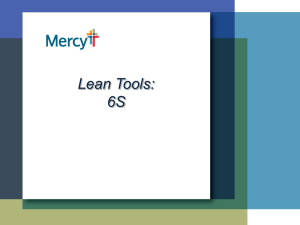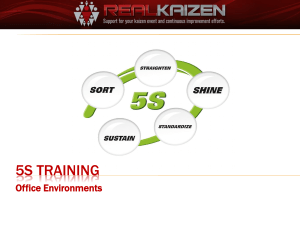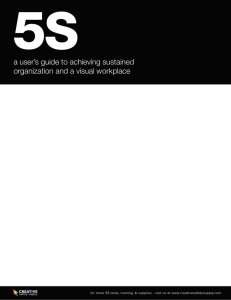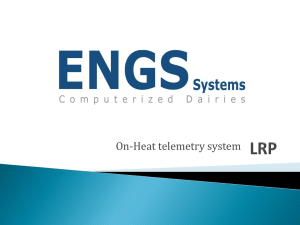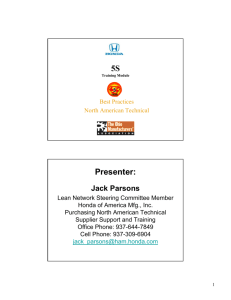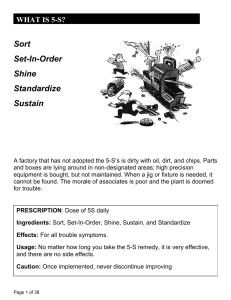Training - 5S+1
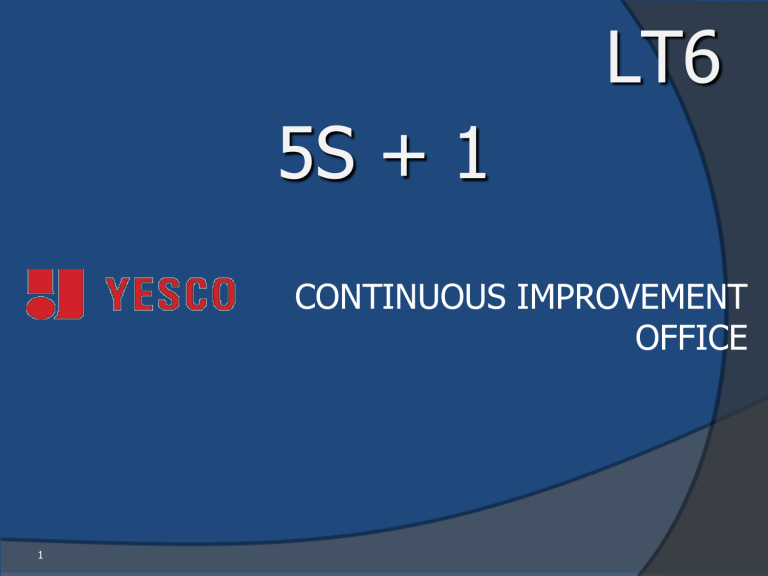
1
LT6
5S + 1
CONTINUOUS IMPROVEMENT
OFFICE
Session Agenda
• Introduction
• Background and History
• Components and Implementation
2
Introduction
• 5S + 1 is a method to improve and sustain workplace organization
• Represents 6 disciplines for maintaining a visual workplace
(visual controls and information systems).
• These are foundational to continual improvement and a manufacturing strategy based on "Lean Manufacturing"
(waste removing) concepts.
• Reduces clutter
• Reduces the time it takes to look for tools and equipment
• “A place for everything and everything in its place”
• Improves how the operation appears to customers – always be “tour ready”
• Creates pride in the workplace
• Many companies have a standard that any tool must be able to be found within 60 seconds.
3
Background and History
• Taiichi Ohno created the original “4S” concept of workplace organization and visual control at Toyota during the early 1950’s.
• The concept was further refined into “5S” during the 1960’s and 1970’s.
• U.S. manufacturers added a sixth “S” for “safety” during the 1990’s.
• The 5S+1 tools were recently modified by
Gwendolyn Galsworth to include “Visual
Workplace” disciplines.
4
Elements of 5S + 1 and Visual Workplace
– Sort
– Scrub/Shine
– Secure Safety
– Select Locations
– Set Locations
– Sustain
5
Elements of 5S +1 & Visual Workplace
• Sort
– Remove all unnecessary materials and equipment
• Scrub/Shine
– Clean everything, inside and out
• Secure Safety (often called “6S” or “5S + 1”)
– A safety commitment in all activities
• Select locations
– Decide where everything remaining should be
• Set locations
– Put remaining items in place, provide “anchors”
• Sustain
– Establish policies and procedures to ensure 5S
6
– Training, daily activities, audits
Types of Waste
• Defects
• Over-Production
• Waiting
• Non-Utilized Talent
• Transportation
• Inventory
• Motion
• Extra Processing
• Other Wastes:
– Inappropriate Systems
– Wasted Utility Resources
– Wasted Materials
7
The Good, Bad and the Ugly
• First the Bad and the Ugly - Life Without 5S
8
The Good – After 5S + 1
9
After 5S + 1
• Clear, shiny aisles
• Color-coded areas
• Posted processes, metrics and other current information
• Always “customer tour ready”
10
5S + 1 Examples
11
Before 5S
After 5S - Cleaned, organized and drawers labeled (less time and frustration hunting)
Sort
• Identify clutter and disposition
• When in doubt, move it out
• Red tag exercise (more later)
12
Scrub/Shine
• Clean everything, inside and out
• Prevent dirt and contamination from reoccurring
• Remove outdated material (like old posted charts, news, and metrics!)
• Results in
– Fewer breakdowns
– Greater safety
– Product quality
– More satisfying work environment
13
Shine Check Sheet
• Ceilings
• Aisles
• Workstations
• Corners, under equipment
• Loading docks
• Walls
• Doors
• Pillars, posts
• Floors
• Machines
• Conveyance equipment
• Plumbing, sinks
• Cabinets, shelves, racks
• Carts, Racks
• Drawers, storage bins
• Fixtures, power boxes
14
5S Examples - Shine
• The area is cleaned as the work is performed (best) and\or there is a routine to keep the work area clean.
15
Safety
• Does not replace the existing site safety plan
• During 5S audits also review all areas for safety
16
Select Locations
• Make it obvious where things belong
– Lines
• Divider lines
• Outlines
• Limit lines (height, minimum/maximum)
• Arrows show direction
– Labels
• Color coding
• Item location
– Signs
• Equipment related information
• Show location, type, quantity, etc.
• Consider your “Value Field”
17
Select Locations Check Sheet
• Equipment
• Machines
• Small tools
• Dies
• Jigs
• Bits
• Conveyance equipment
• Cleaning equipment
• Materials
• Raw material
• Supplies
• Parts
• Work-in-process
• Finished goods
• Shipping materials
• Cleaning supplies
• Furniture
• Cabinets
• Benches, tables
• Chairs
• Carts
• Shelves
• Racks
• Other items
• Charts, graphs, bulletin boards
• Pens, pencils
• Work clothes
• Helmets
• Work shoes
• Trash cans
18
5S Examples
See the difference?
• Sort - All unneeded tools, parts and supplies are removed from the area
• Scrub/Shine – Cleaned/Painted
• Select & Set Locations - A place for everything and everything is in its place
19
Set Locations & Standards
• Establish guidelines for the team 5-S conditions
• Make the standards and 5-S guidelines visual
• Maintain and monitor those conditions
20
Typical Team Standards
• Sort
– Amount of inventory
– Tools that belong in the area
– How often to remove scrap
• Straighten
– Location of aisleways
– Location of tools, equipment
• Shine
– Cleaning schedule
– Maintenance tasks
– Checklist of what to look for as cleaning is performed
21
Sustain
• Determine the methods your team will use to maintain adherence to the standards
• 5-S concept training
• Before and after photos
• Checklists, standards and procedures
• Daily 5-minute 5-S activities
• Monthly 5S Audit
22
5S Implementation
1. Begin reviewing your areas for 5S
2. Discuss 5S with each of your groups (brief group meeting)
3. Red tag sorting process (one time)
4. Brief, simple daily 5S individual activity (“just look around”)
5. Brief 5S checklist or procedure for each area
6. Monthly 5S audit beginning __________
• Area Lead plus at least one person from outside that area
• Post results (I will look for them!)
• Review results with your group
• Take corrective action
23
© 2007 Superfactory™. All Rights Reserved.
Red Tag Process
• One-time activity to remove or disposition clutter
• To be started within two weeks of this training
1. Identify clutter, unused equipment, etc
2. Fill out and attach red tag
3. Note in red tag log
4. Must disposition Red Tags within (XX) days
24
Red Tag Example
Item Tagged by: ________________________
Name of Item: __________________________
Date: _________________________________
Location of Item: ________________________
Reason for Red tagging
(Check One)
Obsolete
Defective
Scrap
Trash
Unneeded
Used once/day
Used once/week
Used < once/month
Seldom Used
Use Unknown
For Office Use Only:
Item No. ___________________________
Disposition:_________________________
__________________________________
25
Red Tag Hints
• Search
– Floors
– Aisles
– Operation areas
– Workstations
– Corners, under equipment
– Small rooms
– Offices
– Loading docks
– Inside cabinets
26
Red Tag Hints
• Look for unneeded equipment
– Machines, small tools
– Dies, jigs, bits,
– Conveyance equipment
– Plumbing, electrical parts
27
Red Tag Hints
• Look for unneeded furniture
– Cabinets
– Benches, tables
– Chairs
– Carts
28
Red Tag Hints
• Search these storage places
– Shelves
– Racks
– Closets
– Sheds
– Search the walls
– Items hung up
– Old bulletin boards
– Signs
29
Red Tag Hints
• Look for other unneeded items
– Work clothes
– Helmets
– Work shoes
– Trash cans
– Other
30
Red Tag Hints
• Look for unneeded materials
– Raw material
– Supplies
– Parts
– Work in process
– Finished goods
– Shipping materials
31
Visual Factory
• Mark-off the inventory locations
• Mark-off equipment/machine locations
• Mark-off storage locations (cabinets, shelves, tables)
• Visually indicate amount of allowed inventory
• Keep metrics, wall charts, and other information current
• Label all cabinets, shelves, etc with their contents
• Posted production status, upcoming jobs
32
33


